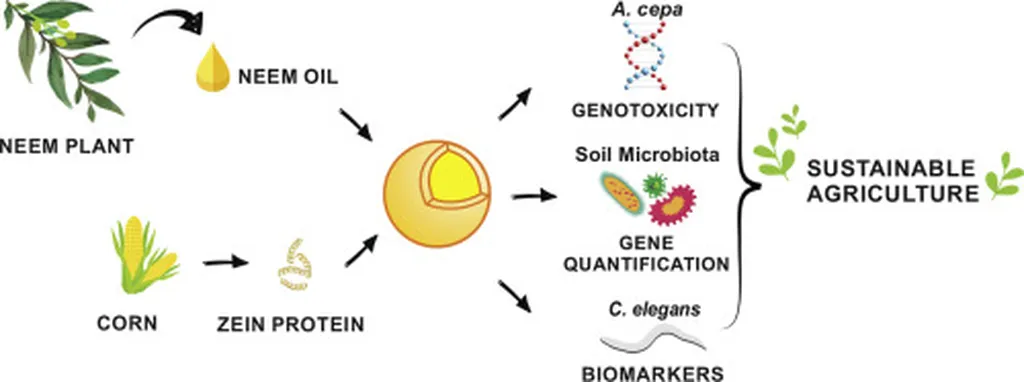In the quest for sustainable and effective pest control, researchers have long turned to botanical biopesticides, lauded for their biodegradability and cost-effectiveness. Among these, neem oil derived from the Azadirachta indica tree has been a beacon of hope, particularly in combating notorious crop pests like the desert locust, Schistocerca gregaria. However, a recent study published in ‘نامه انجمن حشرهشناسی ایران’ has shed light on a potential pitfall in the quest to enhance neem oil’s efficacy through nanotechnology.
The study, led by Nadia Dimetry from the Pests and Plant Protection Department at the National Research Centre in Egypt, explored the impact of transforming neem oil into a nano formulation using high-energy sonication. The results, while promising in some aspects, also raised significant concerns. The nano particles, as observed through Transmission Electron Microscopy (TEM), were spherical and smooth, with sizes ranging from 90 to 120 nm. However, the nano formulation’s performance against the fifth instar nymphs of Schistocerca gregaria under semi-field conditions was less impressive than expected.
Both the bulk neem oil and its nano-emulsion were applied topically at doses of 5 and 2.5 ppm. While both formulations led to increased mortality rates, nymphal malformations, and failed molting compared to the control group, the crude neem oil demonstrated greater effectiveness. This unexpected outcome has sparked a wave of introspection among researchers and industry stakeholders.
“The nano emulsion resulted in a significant extension of duration period in the survived nymphs,” noted Dimetry, highlighting a critical finding of the study. This prolonged development period could potentially allow pests more time to adapt and develop resistance, posing a significant challenge for farmers and agronomists.
The study also delved into the biochemical aspects, revealing that both formulations influenced chitinase activity and total protein levels. However, the nano emulsion’s impact was less favorable. Gas chromatography/mass spectrometry (GC/MS) analysis further indicated the absence of linoleic acid in the nano sample, a compound known for its pesticidal properties. This absence could partially explain the nano formulation’s reduced efficacy.
The commercial implications of these findings are substantial. The agriculture sector has been increasingly investing in nanotechnology to enhance the performance of biopesticides. However, this study serves as a cautionary tale, emphasizing the need for careful consideration and extensive testing before scaling up such technologies.
As the global population continues to grow, the demand for sustainable and effective pest control methods will only intensify. This research underscores the importance of balancing innovation with thorough scientific scrutiny to ensure that the solutions we develop today do not inadvertently compromise our food security tomorrow.
In the words of Dimetry, “The prolonged ultrasonic treatment during preparation of neem oil nano-emulsion adversely affected the active biocompounds presented in neem oil, leading to a reduction in its bioactivity against the fifth instar nymphs of S. gregaria compared to its crude form.” This insight could shape future research and development in the field, steering scientists towards more nuanced and holistic approaches to pest control.
As the agriculture sector grapples with the challenges of climate change, biodiversity loss, and evolving pest resistance, studies like these are invaluable. They remind us that the path to sustainable agriculture is complex and multifaceted, requiring a delicate balance of innovation, tradition, and scientific rigor.

